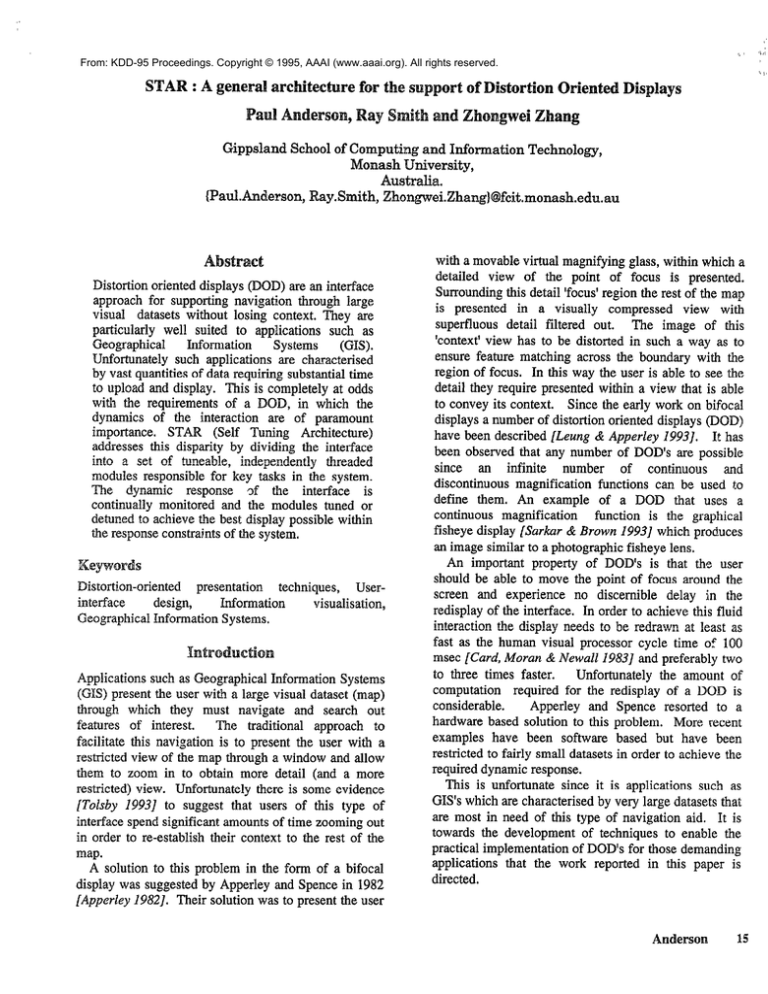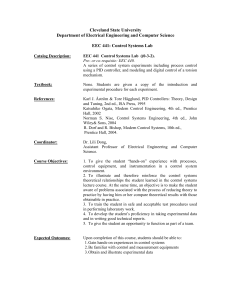
From: KDD-95 Proceedings. Copyright © 1995, AAAI (www.aaai.org). All rights reserved.
STAR : A general architectllare fix the su port of Distortion Oriented Displays
Paul AHadesson, ay Smith and Zbngwei Zhang
Gippsland School of Computing and Information Technology,
Monash BTniversity,
Australia.
PauLAnderson, Ray.Smith, Zhongwei.ZhamgN3fcit.monash.edu.a~
Distortion oriented displays (DQD) are an interface
approach for supporting navigation through iarge
visual datasets without losing context. They are
particularly well suited to applications such as
Geographical Information
Systems (GE).
Unfortunately such applications are chamcterised
by vast quantities of data requiring substantialtime
to upload and display. This is completely at odds
with the requirements of a DBD, in which the
dynamics of the interaction are of paramount
importance. STAR (Self Tuning Architecture)
addressesthis disparity by dividing the interface
intn
.A..U
PPb .,A
nf
I$3 ““I
tnnPahlP
.1A.~U”lV,
iinrlenmnrbntlv
“‘“‘y”Aaa.~‘
LLJ
threarlerl
YllVUUVU
modules responsible for key tasks in the system.
The dynamic response gf the interface is
continually monitored and the modules tuned or
detuEedto achieve the best display possible within
the responseconstraintsof the system.
Distortion-oriented presentation techniques, Userdesign,
interface
Information
visualisation,
GeographicalInformation Systems.
Applications such as GeographicalInformation Systems
(GB) present the user with a large visual dataset (map)
through which they must navigate and search out
features of interest. The traditional approach to
facilitate this navigation is to present the user with a
restricted view of the map through a window and allow
them to zoom in to obtain more detail (and a more
restricted) view. Unfortunately there is some evidence
[Tolsby 19931 to suggest that users of this type of
interface spendsignificant amountsof time zooming out
in order to re-establish their context to the rest of the
map.
A solution to this problem in the form of a bifocal
display was suggestedby Apperley and Spencein 1982
[Apperley 1982]. Their solution was to present the user
with a movable virtual magnifying glass, within which a
detailed view of the point of focus is presented.
Surroundingthis detail ‘focus’region the rest of the map
is presented in a visually compressed view with
superfluous detail filtered out. The image of this
‘context’view has to be distorted in such a way as to
ensure feature matching across the boundary with the
region of focus. In this way the user is able to see the
detail they require presentedwithin a view that is able
to convey its context. Since the early work on bifocal
displays a number of distortion oriented displays (DOD)
have been described[Leung & Apperiey 19931. It has
been observed that any number of DOD’s are possible
since an infinite number of continuous and
discontinuous magnification functions can be used to
define them. An example of a DOD that uses a
continuous magnification function is the graphical
fisheye display [Sarkar & Brown 19931 which produces
an image similar to a photographic fisheye lens.
An important property of DOD’s is that the user
should be able to move the point of focus around the
screen and experience no discernible delay in the
redisplay of the interface. In order to achieve this fluid
intemrtinn
.......a..w.A -*.
the
U..,
dicnlav
“‘“y’“J
nedc
II..“UY
tn
L” he
“V
rwlrawn
IV\IIU”IAI
cat AVUUL
1~1lct USI
90
UC
fast as the human visual processor cycle time of 100
msec [Card, Moran & Mewall 19831 and preferably two
to three times faster. Unfortunately the amount of
computation required for the redisplay of a DQD is
considerable. Apperley and Spence resorted to a
hardware based solution to this problem. More recent
examples have been software based but have been
restricted to fairly small datasetsin order to achieve the
required dynamic response.
This is unfortunate since it is applications such as
GIS’s which are characterisedby very large datasetsthat
are most in need of this type of navigation aid. It is
towards the development of techniques to enable the
practical implementation of DOD’s for those demanding
applications that the work reported in this paper is
directed.
Anderson
15
Related Work
Some previous work has been done [Robertson, Card &
Mackinlay 19931 in the developmentof an Information
Visualizer Architecture aimed at providing large
workspaces, multiple agents, real-time interaction and
visual abstractions. At the heart of their architecture is
the Cognitive Coprocessor which is a controlled
resource scheduler. The Cognitive Coprocessorhas a
Governer mechanism that monitors the display cycle
time and directs cooperating rendering processes to
reduce rendering quality to increase cycle speed when
the cycle time is too slow.
The Self Tuning ARchitecture (STAR) described in
3-i-P..- e.....
Al-. “--.&frl.._
” _--______-:.this paper airrers
nom me
Logmnve Loprocessor
in ALuie
following ways :
designed for use with very large complex datasets
(eg GIS) and navigation within these using DOD
techniques
uses a range of regimes for reducing image
complexity in the context region to adjust re-display
time dynamically
the regimes are independentof the architecturewith
appropriatetechniquesbeing chosen for the type of
display being supported
the range of regimes are controlled through the use
of a single encompassingtuning variable
Demanding Applications
In order to indicate the magnitude of the problem
involved in implementing a DOD, the following
measurements were obtained for a GIS (Infocad)
running on a HP9000 715/75 with a graphics
accelerator.
Admittedly the above example is for a fisheye display
which involves considerably more computation than
simple DOD such as bifocal. However the objective of
this work is to deveiop an architecture capabie of
So how can this
supporting any type of DOD.
enormousdisparity between the time taken to produce a
DOD and the dynamic responsebe addressed?
Common to all DOD is the division of the display
lA single vector in the original data can translateinto a
numberof vectorswithin the fisheyedisplay.
16
KDD-95
into a focus region, representingthe virtual magnifying
glass that the user moves around the screen and one or
more context regions that allow the user to view the
relationship between features in their current focus with
those outside the focus. It follows that in general all the
data that can be presentedin the focus region should be
displayed (since this contains the information that the
user is looking for) whereas only a subset of the
available data need be displayed in the context region.
Extending this idea further, degradation of the context
image is more acceptablethan degradationof the focus.
Hence tuning of the interface should concentrateon the
context image. The gains that can be achieved by this
may, in some cases, be greater than immediately
obvious. The context image needs to be distorted in
order to achieve feature matching across the boundary
with the focus region. The data transform required for
this distorted image may require substantial
computation. Reducing the quantity of data that needs
to be transformed in this way can produce a large
reduction in this computational overhead.
As discussedabove, DOD usually divide the display
into focus and context regions. In the focus region the
data is generally undistorted and it is relatively easy
(fast) to calculate the data manoings
in this
region The
Tz~--9.~~~
~~~~~
--“----.
focus region presents the highest magnification of the
display. Some data will be associatedwith items that
are too small to be visible in this region. It follows that
these data items would be too small to be visible
anywhere on the display, and consequently can be
filtered at source. Our experiencewith real datasetshas
shown that this typically reducesthe quantity of data by
-80 %. In addition to this general size filtering some
areasof the map offer very high levels of detail. Within
the context region such detail is beyond the resolution of
the display. Hence a further size based filtering can be
applied basedon data population densities.
The context region is there to show context. It
follows that much of the detail in this region not only
could but should be removed. Within STAR this is
achievedby selecting data basedon user defined layers.
The calculation of data mappings in the context region
is often complex and incurs a major time penalty, hence
any reduction in this region can produce considerable
gains in performance.
Annrt
--=--
frnm these
static
---_---d-- L-----
fi_l@%w P regimes.
--D------T
a-- number
of
dynamic filtering approachesare possible and it is these
that form the backboneof the STAR architecture. The
basis of this approachis the dynamic adjustment of the
quantity of data displayed based on measured system
performance. Each drawing request is manifested as a
time stamped event in a queue. The time taken to
service requests can hence be monitored and the
quantity of data displayed modulated in line with the
difference between the actual response time and the
optimal (ideal) responsetime. This dynamic adjustment
is referred to as tuning.
Tuning Variables
A number of parameters can be monitored to adjust the
system performance. These include:
i) Polynomial Term Limit
Within some DOD a straight line in the original map
translates into a curved line within the distorted
region of the display. One approach to achieve this
mapping is by fitting a polynomial to the data.
Obviously the greater the number of terms calculated,
the better the mapping. On the other hand the
calculation of more terms incurs a greater calculation
overhead, and a greater drawing overhead since the
resulting data is then mapped onto an increased
number of vectors. Reducing a limit on the number
substantial
~-----of terms r.&Ul&d_ can nroduce
performance improvements. Such approximations
within a distorted image used purely for establishing
context are entirely reasonable.
ii) Size Filtering
Static filtering of data based on size was described
above. Increasing the minimal size of data items
within the context region is simple to implement and
has a low filtering overhead. An upper limit, beyond
which the minimal size cannot be extended needs to
be set otherwise all of the data could be removed in
preference to the application of other tuning regimes,
which would be unreasonable.
iii) Layer Based Filtering
Data in the GIS is categorised on the basis of user
defined levels (the more important the level the
lower the level number). This level information is
used for static filtering of context region information.
If two or more user defined data levels are displayed
in the context region then the maximum level number
can be dynamically adjusted to filter out whole
categories of data. The overhead incurred in this
approach is very low.
Other tuning variables may be possible for particular
“--WV.. . .
types ot DUD. wnat 1simportant with a tuning variable
is that the overhead incurred in applying the filter is less
than the performance gain obtained by applying it.
The Tuning Process
In practice, a number of tuning variables can be
identified in the system. In this section we will consider
a simplified system that has only a single tuning
variable TV, that represents the percentage of the
available data that is to be presented within the context
region of the display. Practical values for TV might be
10 through 100.
The tuning process monitors the time taken to redraw
the screen. Let us assumean optimal redraw time of 50
msec. A redisplay time of more than this means the
system is not responding fast enough and needs to be
detuned, ie TV needs to be reduced. Conversely, if the
redisplay time is less than 50 msec then it would be
possible to produce a better display within our time
constraint, so TV can be increased.
Let us now consider how the user is likely to perceive
these changesin performance. Users do not continually
move the focus region around. As is the case with all
computer systems the interaction between user and
system is characterised by bursts of action interleaved
with periods of complete inactivity. Focusing on the
response of the system at the start of one of these
activity bursts, consider the following two cases :
l
l
TV is too high, and the resulting system response is
too low ( Figure la).
TV is too low, and the resulting system response is
more than acceptable( Figure 1b).
In the first case the lack of performance will result in
the tuning process reducing TV to compensate.
However, from the user viewpoint the interaction will
initially seem to be sluggish. In the second case no such
change in system performance will be perceived by the
user. It follows from this that it is better to start with TV
too low, and tune the system up than to have the
converse case.
An additional benefit of starting with TV too low is
that the system will tune itself to optimal performance
quicker since adjustment of TV can only occur at the
completion of each display interval.
The scenario presented above makes the following
assumptions:
1. Burst mode activity is the norm.
2. The data distribution across the screen is uniform.
Point 1 is probably valid, however 2 is probably not. If
data distribution is not uniform (i.e., point 2 not valid) it
will result in a constantly changing re-display rate,
hence TV would oscillate up and down rather than
following a straight line as depicted in Figure 1. The
question then arises as to how the user perceives this
changing performance. The answer is surely that if the
user perceives any change in dynamics of the system,
then that is a bad thing.
Anderson
17
Activity
4
v==-
Figure 1: Alternative tuning scenarios.
Since users will only perceive changes if the redisplay interval becomes greater than a. certain
threshold (-50 msec) it is arguably better to tune the
interaction interval to a period shorter than the tbreshold
so intervals that give rise to detuning are not perceived
by the user.
Periods of user inactivity need to be consideredas a
special case since during these periods the display
should be presentedin its most complete form. The rate
at which the user is moving the point of focus can be
easily monitored. 1.fthis scan speedis found to be zero,
the TV could be set to 100 to achieve optimal image
quality. However, the next burst of activity would be
likely to give rise to a redisplay interval greaterthan the
redisplay threshold with the result being that the user
1 * 1oecomeaware of a cnange
.,.- - m
f.. perrormwce.
.--.I- --..-- rr..woum
one
solution is for the tuner processto monitor scan speed
and at the start of a new burst to set TV at a low level
(Figure 2 ).
IFIthe algorithm presentedin Figure 2, TV is adjusted
in incrementsof a fixed size. An obvious improvement
in this would be to adjust the size of the increment in
line with the magnitude of the difference between
redisplay-in#erval
and redisplay-threshold,
hence
forcing tie redisplay-interval
to converge to the
18
mm-95
(This assumes a linear
threshold more rapidly.
relationship between redisplay-interval and TV. If TV
simply controls the quantity of data being displayed
then this may be true).
In the discussionpresentedabove there was only a
single tuning variable. Hnpractice there is the potential
for any number of tuning variables that control
parameters such as the minimum size of vectors
displayed,the number of polynomial terms calculated in
mapping vectors to a context surfaceand so on.
Pn dealing with a set of tuning variables the question
arisesas to which should be adjusted,and by how much.
Hnthe generalcasethis cannot be defined since different
types of DCH3are likely to have different sets of tuning
variables.What can be done is:
B suggesta schemefor managingtuning variables
0 suggest approachesfor identifying which tuning
variablesshould be adjusted,and by how much.
TVINC-5
stationary- TRUE
REPEAT FOREVER
GET scan-speed
IF stationaryTHEN
IF scan-speedNE0 THEN
stationary- FALSE
// eg 10
TV - 1owerJnit
ENDIF
// not stationary
ELSE
IF scan-speedEQ 0 THEN
stationary- TRUE
TV-100
ENDIF
ENDIF
IF NOTstationary THEN
GET redisplay-interval
._--iF redispiay_intervakredispiayJhmhold THEN
IF TV<100 THEN
TV-Tv+TvINc
ENDIF
ELSEIF redisplayJntervalxedisplay_threshold THEN
IF Tv>lowerJmit THEN
TV-TV-TVINC
ENDIF
ENDIF
ENDIF
END REPEAT
Figure 2 : Tuning Algorithm
The scheme used for managing variables in STAR
relies on maintaining a simple primary tuning variable
Tp and defining a function mapping the value of Tp to
the value of each specific tuning variable in the system.
In this system,changing the value of Tp ( between 0 ..
100) results in one of the more specific tuning variables
being adjusted in line with the tuning function. (In the
implementation the tuning function simply maps onto a
table, permitting the new values for specific tuning
variables to be rapidly located). Given this schemethe
tuning systemof STAR can be defined in the following
way.
The tuning system S = { Tp, T, Ft, Nt }
where
T
- the primary tuning variable
Tp - a set of specific tuning variables
- a function mapping Tp + TX,
Ft
Nt
= the number of specific tuning variables
Any number of tuning variables (Ft) could be defined.
However a set of criteria for identifying acceptable
tuning functions can be stated, reducing the number of
alternatives. The first criteria is that the relationship of
Tp to the redisplay-interval (Ri) should be linear. This
is desirable to facilitate rapid convergenceof run-time
tuning. The secondcriteria is that the display should be
the best possible. Given two displays produced in the
sameRi, the one containing the most data is iikeiy to he
the best.
The question then arises as to how an acceptable
tuning function is found. Since the performance of the
interface is closely related to the size and distribution of
the visual dataset,any tuning function will have to be a
compromise. However an empirical approachbased on
a large uniform artificial data set is possible. Given N,
tuning variables, each would have a specific number of
possible values (between 1 .. N(x)). The number of
permutationsis the product of Nfx)
x * 1-cc_.
N,.c- Hence
\~~,for
~~~~
------given 4 tuning variables, each with 10 possible values (a
worst case scenario), the number of permutations is
10000. An artificial dataset with a dense,uniform data
distribution could be automatically scanned with the
specific tuning values set to each one of these
permutations and the redisplay interval recorded for
each. If Ri is 0.1 msec, with 10 samplesbeing taken for
each permutation, the complete scan could be carried
out in 10000 set or about 3 hours.
To locate the appropriate permutations from the
resulting data the shortest and longest redisplay interval
within the range O..redispZay-threshold would be found
and the correspondingpermutation recorded. Next the
interval covered could be divided into an appropriate
number of steps (10 or 100) and the nearest mapping to
each step interval located in the database. These would
then represent the appropriate mappings for T
correspondingto each interval. This empirical approacK
to defining the tuning function would only need to be
carried out for each new type of DOD, the same
mnnninu
----l-l-‘--D
h&p
fnr
D ~laecl
-“-a-*
nll
. ..a datrrcet
. . . . . . . euamind
Il....A.l*l”Y
henmfnrth
.I”~~V”L”~UA.
Other techniques for finding appropriate mappings
may be possible. For example, rather than having a
separatetuning phase,the system could monitor its own
performance as it is used and devise its own tuning
functions. Genetic algorithms, neural network or fuzzy
logic techniquesmay be applicable for this purpose.
The STAR Architecture
The STAR architecture can functionally be divided into
rl---_
df+-.L aivisrons,
3*--*-*.~.. responsiblefor data acquisition
three ursunct
(uploading), data transformation and display, and
performance monitoring and tuning (Figure 3).
Changing from one form of DOD to another only affects
the data transformation and display module.
Anderson
19
Moscow Russia. Selected Papers, August 1993 pp 141151
Leung, Y. and Apperley, M. : A Unified Theory of
Distortion-Oriented
Presentation Techniques. Massey
University School of Mathematical and Information
SciencesReport Series A No 93/l.
Apperley, M.; Tzavaras, I. and Spence, R. : A
Bifocal
Figure 3: The STAR architecture.
In addition to the basic capabilities of the data
acquisition modules, STAR also provides for a planning
function to be incorporated into this module. The
planning function monitors each request for data and
attempts to make intelligent predictions as to what data
will be required in the very near future. These requests
are then added to the request queue with a low priority.
In this way it may be possible to achieve improved
performance.
Conclusion and Discussion
The STAR architecture relies on a combination of static
and dynamic filtering in order to achieve the dynamic
responserequired of a DOD. A working prototype has
been implemented that has demonstrated the feasibility
of this approach. So far only display output issueshave
been addressed, since it was felt that the problems of
achieving the required level of performance were of the
greatest importance for demanding applications.
Having tackled this issue, we now plan to investigate
user input through the display. The quantities of data
involved are relatively small, hence it is felt that this
side of the interaction should not present any great
difficulties.
Finally we plan to investigate a number of different
types of DOD. Our initial investigations indicate that
DOD based on continuous transform functions are better
suited to practical use, since their apparent distortion is
less than that seen with simple DOD types such as
bifocal. Released from the shackles of performance
constraints, we will have a largely free rein to assessany
form of distortion transform that seemspromising.
References
Tolsby, H. : Navigating in a Process Landscape. HCI
Proceedingsof 3rd International Conference EWCHI ‘93
20
KDD-95
Display
Technique
for
Data
Presentation.
Eurographics ‘82 pp 27-43., DS Greenaway, EA
Warman (eds) North-Holland Publishing Company
Card, S.; Moran, T. and Newell, A. : The Psychology
of Human-Computer
Interaction.,
Erlbaum Ass.,
Hillsdale, New Jersey, 1983
Robertson, G.; Card, S. and Ma&inlay, J. :
Znformation
Visualization
Using 30
Animation., Communications of the ACM
Interactive
April 1993
Vo136 No 4, pp 57-71.
Sarkar, M. and Brown, M. : Graphical Fisheye Views.
Technical Report CS-93-40, Dept. of Computer
Science, Brown University September 1993.






